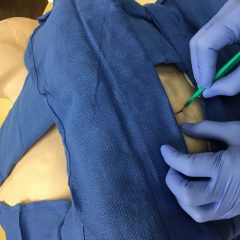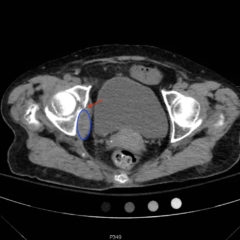A Simulation Model for Extensor Tendon Repair
ABSTRACT
Audience:
This simulation model is designed for use by emergency medicine residents. Although we have instituted this at the PGY-2 level of our residency curriculum, it is appropriate for any level of emergency medicine residency training. It might also be adapted for use for a variety of other learners, such as practicing emergency physicians, orthopedic surgery residents, or hand surgery trainees.
Introduction:
Tendon injuries commonly present to the emergency department, so it is essential that emergency physicians be competent in evaluating such injuries. Indeed, extensor tendon repair is included as an ACGME Emergency Medicine Milestone (Milestone 13, Wound Management, Level 5 – “Performs advanced wound repairs, such as tendon repairs…”).1
However, emergency medicine residents may have limited opportunity to develop these skills due to a lack of patients, competition from other trainees, or preexisting referral patterns. Simulation may provide an alternative means to effectively teach these skills in such settings. Previously described tendon repair simulation models that were designed for surgical trainees have used rubber worms4, licorice5, feeding tubes, catheters6,7, drinking straws8, microfoam tape9, sheep forelimbs10 and cadavers.11 These models all suffer a variety of limitations, including high cost, lack of ready availability, or lack of realism. We sought to develop an extensor tendon repair simulation model for emergency medicine residents, designed to meet ACGME Emergency Medicine Milestone 13, Level 5. We wished this model to be simple, inexpensive, and realistic.
Objectives:
By the end of this educational session, the learner will be able to: 1) List the indications for extensor tendon repair in the emergency department, 2) recognize the indications for referral to orthopedic or hand surgery, 3) list the risks and benefits of emergency department extensor tendon repair, 4) perform an appropriate physical examination for a patient with a potential extensor tendon laceration, 5) list the maximum time limit of tourniquet application for this procedure, 6) list the materials needed for extensor tendon repair in the emergency department, 7) successfully repair a completely severed extensor tendon using four different techniques: horizontal mattress, figure of eight, modified Kessler and modified Bunnell, and 8) describe the appropriate splinting of a repaired extensor tendon.
Methods:
The learner responsible content/educational handout component of our innovation teaches residents about emergency department extensor tendon repair, and includes: 1) relevant anatomy 2) indications and contraindications for emergency department extensor tendon repair 3) physical exam findings 4) tendon suture techniques and 5) aftercare.
During their PGY-2 year, emergency medicine residents are provided the learner responsible content/educational handout on a rotating basis. Residents are provided these materials approximately three weeks prior to a scheduled simulation lab session. The learner responsible content/educational handout are to be completed prior to the simulation lab session. The learner responsible content/educational handout are estimated to take residents one hour to complete.
During the scheduled lab session, each resident is supplied two whole pig feet and suture material. Under faculty supervision, residents dissect out extensor tendons and perform tendon repairs using four different tendon repair stitches: the modified Kessler, the modified Bunnell, the figure-of-eight, and the horizontal mattress stitch. The hands-on lab takes approximately one hour for residents to complete and requires the presence of a single supervising faculty member.
We developed an extensor tendon repair simulation model for emergency medicine residents, designed to meet ACGME Emergency Medicine Milestone 13, Level 5.1 This model includes both an learner responsible content/educational handout component and a simulation model. This educational innovation is simple, inexpensive, realistic, and requires limited faculty time.
This simulation model has been well-received by our resident and faculty, and successfully addresses this particular ACGME Milestone.
Topics:
Simulation training, tendon repair, extensor tendons of the finger, orthopedics, hand.


